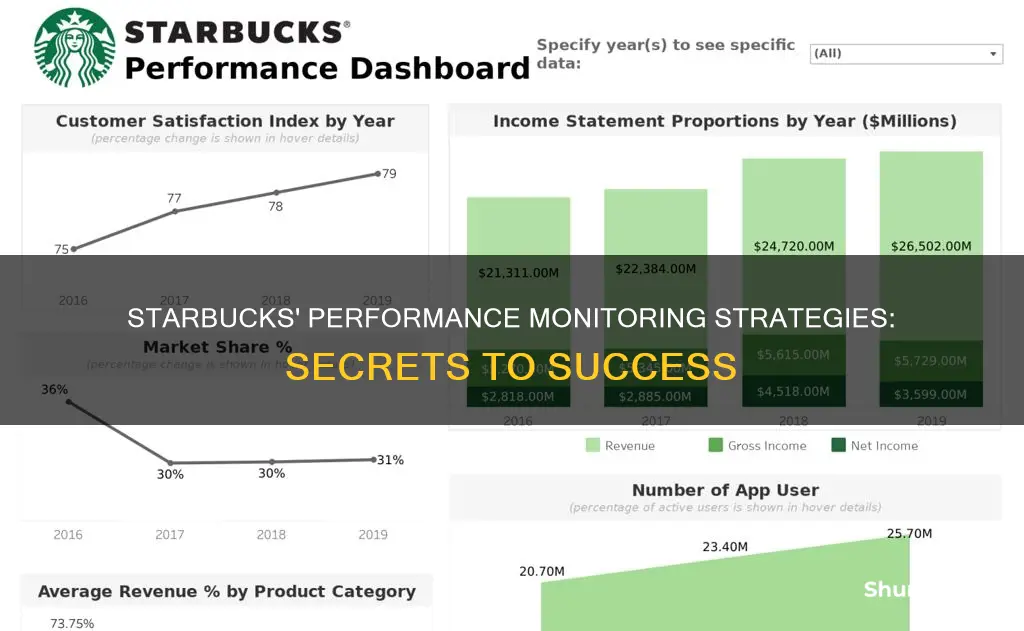
Starbucks is a global coffee shop chain with over 25,000 stores worldwide. The company has established a robust system of performance monitoring to ensure operational efficiency and customer satisfaction. To monitor its performance, Starbucks collects and analyses data from various sources, including sales data, customer feedback, and employee performance metrics. The company uses digital tools and analytics to gain insights into sales trends and customer behaviour, and identify areas for improvement. By leveraging data intelligence platforms, such as Atlas by Esri, Starbucks can make informed decisions about new store locations, product offerings, and marketing strategies. Additionally, Starbucks prioritises employee satisfaction and recognises the importance of employee accomplishments in maintaining its culture and community focus. The company's success is attributed to its ability to manage data effectively and utilise key performance indicators (KPIs) to measure and analyse its performance across different business areas.
| Characteristics | Values |
|---|---|
| Sales performance | Tracked in real-time to identify trends, analyze customer preferences, and adjust product offerings |
| Customer feedback analysis | Gathered through surveys, social media, and online reviews to identify areas for improvement and address concerns |
| Operational efficiency | Evaluated through store traffic, wait times, order accuracy, and employee productivity to streamline processes and enhance service delivery |
| Product performance | Assessed through sales data analysis, customer feedback, and market research to identify opportunities for innovation |
| Employee performance | Monitored through engagement, satisfaction, and productivity metrics to identify training needs, recognize top performers, and foster a positive work environment |
| Customer relationship management | Utilized to track sales data, manage customer interactions, and analyze performance metrics |
| Data collection | Leveraged through reward programs and mobile apps to understand purchasing habits and personalize experiences |
| Data usage in promotions and marketing | Targeted and personalized offers and discounts sent via marketing emails |
| Data analytics and product/sales decisions | Utilized to identify new store locations, expand product markets, and determine menu updates |
| Global Responsibility Report | Includes 6 categories of KPIs in the Global Reporting Initiative Performance Indicators: Economic, Environmental, Labor Practices, Human Rights, Society, and Product Responsibility |
What You'll Learn

Sales performance tracking
One of the primary benefits of sales performance tracking for Starbucks is the ability to optimise revenue generation and drive profitability. With access to real-time sales data, the company can make data-informed decisions about its product mix, pricing, and promotions. This allows Starbucks to adapt its offerings to meet the changing needs and preferences of its diverse customer base.
Additionally, sales performance tracking helps Starbucks identify high-performing and underperforming products. By analysing sales data at a granular level, the company can determine which products are popular among its customers and which products may need to be discontinued or improved. This enables Starbucks to continuously refine its product portfolio, ensuring that it remains relevant and appealing to its target market.
Sales data also plays a crucial role in Starbucks' market research and customer segmentation strategies. By combining sales data with customer feedback and market research, Starbucks can gain a deeper understanding of its customers' needs, wants, and preferences. This information is then used to create targeted marketing campaigns, develop new products, and enhance the overall customer experience.
Furthermore, sales performance tracking allows Starbucks to identify trends and patterns in customer behaviour. For example, by analysing sales data, Starbucks can determine peak sales periods, busy store locations, and the impact of external factors such as weather conditions or special promotions on sales. This information is invaluable for optimising staffing levels, inventory management, and store operations.
In conclusion, sales performance tracking is an essential tool for Starbucks to maintain its competitive edge in the dynamic coffee industry. By closely monitoring and analysing sales data, Starbucks can make data-driven decisions, optimise its product offerings, and ultimately, enhance customer satisfaction and drive business growth.
Monitor Height: A Quick Guide to Eye-Level Screens
You may want to see also

Customer feedback analysis
Starbucks places a lot of emphasis on customer feedback analysis. The company uses a variety of channels to gather and analyze customer feedback, including surveys, social media, and online reviews. This feedback helps Starbucks identify areas for improvement and address customer concerns promptly. With the help of survey tools like Qualtrics, Starbucks designs customized feedback forms to measure customer satisfaction effectively.
Starbucks's reward program and mobile app have played a significant role in collecting customer data and understanding their purchasing habits. The mobile app has over 17 million active users, while the reward program has 13 million active users. This has allowed Starbucks to personalize the customer experience by recommending new products and suggesting new items that customers might be interested in trying. The company's Digital Flywheel program, a cloud-based artificial intelligence engine, analyzes customer preferences and makes personalized recommendations based on factors such as weather, holidays, and location.
Starbucks also uses customer feedback to make data-driven decisions about its product offerings. By analyzing sales data, customer feedback, and market research, Starbucks evaluates the popularity of existing products and identifies opportunities for innovation. The company utilizes tools like Tableau for advanced data visualization and trend analysis, guiding product decisions and driving business growth.
In addition to surveys and feedback forms, Starbucks also pays attention to online reviews and social media sentiments. They monitor customer satisfaction levels and identify areas where they can enhance the overall customer experience. This comprehensive approach to customer feedback analysis allows Starbucks to stay connected with its customers and make informed decisions to improve its products and services.
Disassembling the Asus VN248 Monitor: Removing the Stand
You may want to see also

Operational efficiency
Starbucks' operational efficiency is a crucial aspect of its success, ensuring consistency and quality across its vast network of stores. The company employs several strategies to maintain and improve operational efficiency, leveraging the power of data and technology.
One key strategy is the use of performance monitoring tools to evaluate various factors, including store traffic, wait times, order accuracy, and employee productivity. By identifying bottlenecks and implementing operational improvements, Starbucks optimises its processes and enhances service delivery. For example, they might use platforms like Toast POS, which integrates inventory management and sales tracking, to streamline operations.
Additionally, Starbucks has developed a robust system of data collection and analysis to inform their operational decisions. With 90 million transactions a week across 25,000 stores worldwide, Starbucks has access to vast amounts of data. They utilise this data to understand customer preferences, purchase habits, and behaviour. This data-driven approach enables Starbucks to make informed decisions about product offerings, store locations, and marketing strategies.
The Starbucks Rewards programme and mobile app have played a significant role in enhancing their data collection capabilities. With millions of active users, Starbucks can gather insights into customer behaviour, such as preferred drinks, purchase patterns, and ordering habits. This data enables Starbucks to personalise the customer experience, suggest new products, and even predict future purchases.
Furthermore, Starbucks has invested in innovative technologies, such as artificial intelligence, to enhance operational efficiency. Their Digital Flywheel program, a cloud-based AI engine, provides customers with tailored food and drink recommendations based on various factors like weather, location, and time of day. This technology not only improves the customer experience but also optimises inventory management and streamlines the ordering process.
By combining performance monitoring, data analytics, and technological advancements, Starbucks continually improves its operational efficiency, ensuring that customers receive fast, accurate, and consistent service across all touchpoints.
Who Manufactures Acer and Asus Monitors? LG's Involvement Explored
You may want to see also

Product performance
Starbucks continuously evaluates the performance of its product offerings to ensure they remain relevant and appealing to its diverse customer base. The company employs several strategies and tools to monitor and improve its product performance.
One key method is sales data analysis, where Starbucks tracks sales data in real-time across its various locations. This enables the company to identify trends, analyze customer preferences, and adjust its product offerings accordingly. For instance, Starbucks leverages the power of data intelligence through Atlas, a mapping and business intelligence tool developed by Esri. Atlas evaluates data such as proximity to other Starbucks locations, demographics, and traffic patterns to inform decisions about new store locations and product expansion.
Additionally, Starbucks values customer feedback and market research to assess product performance. They gather feedback through channels like surveys, social media, and online reviews, allowing them to identify areas for improvement and address customer concerns. The company also utilizes customer segmentation to gain insights into customers' personal tastes, values, and lifestyle choices. For example, Starbucks introduced health-conscious and plant-based options to cater to a segment of customers prioritizing sustainability and non-dairy alternatives.
Starbucks also conducts in-store product testing to assess the appeal of new product concepts. They strategically select "secret" locations to organically measure customer responses to new items, helping them identify potential design flaws and make informed decisions about global product launches.
Furthermore, Starbucks leverages its rewards program and mobile app to collect valuable data about its customers' purchasing habits, favourite drinks, and ordering patterns. This data enables Starbucks to personalize the customer experience, provide targeted recommendations, and suggest new products based on individual preferences.
By combining sales data analysis, customer feedback, market research, and data intelligence, Starbucks optimizes its product performance, ensuring it remains responsive to the needs and preferences of its diverse customer base.
Fixing LCD Monitors: DIY Guide to Screen Repair
You may want to see also

Employee performance
Starbucks' success and global presence can be attributed to its performance management and careful consideration of all business areas. The company has a robust system of performance monitoring, where key metrics are meticulously tracked and analysed to ensure operational efficiency and customer satisfaction. Employee performance is a vital component of this.
Starbucks monitors performance metrics such as employee engagement, satisfaction, and productivity. By tracking these metrics, the company can identify training needs, recognise top performers, and foster a positive work environment. Solutions like HotSchedules provide workforce management capabilities, allowing Starbucks to optimise scheduling and labour costs. This helps improve employee scheduling and ensure adequate staffing during peak hours.
Employee Training and Development
Starbucks offers its employees, referred to as
Employee Recognition and Community
Starbucks measures success based on employee accomplishments and recognises employees for doing something special for another employee, a customer, or the community. This philosophy of respect and care for the community is integral to the company's culture. Employees are recognised for treating everyone with respect and demonstrating care, which, in turn, positively impacts the business.
Employee Satisfaction and Opportunities
Starbucks prioritises employee satisfaction and offers opportunities for employees to feel valued and engaged in their work. For example, the company implemented the Bean Stock plan in 1991, allowing full-time and part-time employees to buy stocks after six months of employment. This initiative provides employees with a sense of ownership and investment in the company's success.
Data-Driven Decisions
Starbucks leverages data analytics and artificial intelligence to enhance its performance. With 90 million transactions a week across 25,000 stores worldwide, the company uses data to understand customer preferences, optimise marketing and sales strategies, and make informed business decisions. This data-driven approach enables Starbucks to personalise the customer experience, target its marketing efforts, and identify trends to stay competitive in the industry.
Hooking Up 3 Monitors to a KVM: A Step-by-Step Guide
You may want to see also
Frequently asked questions
Starbucks tracks sales data in real-time across its various locations. This enables the company to identify trends, analyze customer preferences, and adjust its product offerings.
Starbucks places a lot of emphasis on gathering and analyzing customer feedback through surveys, social media, and online reviews. This allows the company to identify areas for improvement and promptly address customer concerns.
Starbucks evaluates factors such as store traffic, wait times, order accuracy, and employee productivity. By identifying bottlenecks and implementing improvements, Starbucks can streamline its processes and enhance service delivery.
Starbucks evaluates the performance of its products through sales data analysis, customer feedback, and market research. This helps the company assess the popularity of existing products and identify opportunities for innovation and product development.







